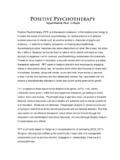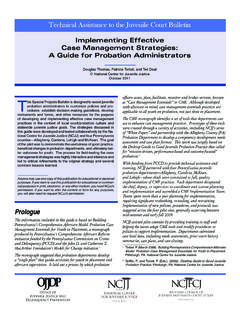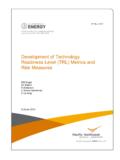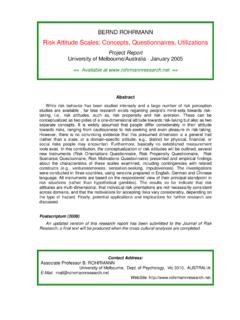Transcription of Environmental Systems - ENCYCLOPEDIA OF LIFE SUPPORT ...
1 UNESCO EOLSSSAMPLE CHAPTERSENVIRONMENTAL Systems Vol. I - Environmental Systems - Achim Sydow ENCYCLOPEDIA of Life SUPPORT Systems (EOLSS) Environmental Systems Achim Sydow National Research Center for Information Technology ( ), Berlin, Germany Keywords: system , Systems identification, parameter estimation, data base, validation, sensitivity analysis, Systems analysis, information system , multicriteria optimization, hierarchical optimization, logistic growth, exponential growth, population dynamics, linear Systems , nonlinear Systems , distributed parameter Systems , concentrated parameter Systems /lumped parameter Systems , maximum likelihood estimation, risk analysis, air pollution, monitoring, traffic system , water quality, uncertainty, fuzzy set.
2 Life SUPPORT , sustainable development, diffusion, dispersion, determinism, stochastic Systems , self-organizing Systems , cybernetics, ozone, water quality, sensor network, telematics, satellites, information technology, data filtering, aggregation models, decision making, Environmental protection, continuous Systems , discrete Systems , control, conceptional model, knowledge-based Systems , expert Systems , Bayesian probability theory, normal distribution, statistical classification, neuronal nets, system ecology, dissipative structure, state variable, self-organisation, entropy, thermodynamics, holistic consideration, input/output analysis, ecosystems, prey-predator Systems , biosphere, technosphere, simulation, traffic, geographical models, landscape models, integrated models, dispersion models, global change, transport processes, micro-scale, macro-scale, global scale, Eulerian models, Lagrangian models, experimental Systems analysis.
3 Theoretical Systems analysis, data base, large Systems , linear programming, dynamic programming, Bellmann s optimization principle, Pareto-optimal solutions, efficient solution, Lagrange function, Lagrange equations, compromise, distributed computation, parallel computation, rank order optimization, decomposition, forest management, agrarian management, hierarchical Systems , geographical information Systems (GISs). Contents 1. Introduction: Systems Approach to Environmental Objects Environmental system Conception Complexity of Environmental Systems Systems Analysis 2.
4 Measurements: Data Capture, Validation, Interpretation 3. Modeling: Model Types, system Identification and Parameter Estimation Types of system Models 4. Decision SUPPORT : Optimization, Multicriteria Approach, Hierarchical Optimization Classical Approach Multicriteria Conceptions Hierarchical Optimization 5. Applied Systems Analysis: Urban and Regional Studies and Information Systems DYMOS-Dynamic Models for Smog Analysis Acknowledgement Glossary Bibliography Biographical Sketch UNESCO EOLSSSAMPLE CHAPTERSENVIRONMENTAL Systems Vol. I - Environmental Systems - Achim Sydow ENCYCLOPEDIA of Life SUPPORT Systems (EOLSS) Summary Erkenne, was die Welt im Innersten zusammenh lt.
5 Wie alles sich zum Ganzen webt, eins in dem anderen wirkt und lebt. (Faust, Goethe) To enable the use of data sets for management and protected classical and non-classical methods of data filtering and aggregation, modeling and decision making, as well as monitoring are required. This asks for Environmental agencies and related companies to collect large, raw data sets. But there is the bottleneck of evaluating the data and applying them for Environmental management and protection. Therefore, statistical methods of data handling have been developed.
6 More and more challenging tasks of Environmental management and protection have forced the conceptualization and development of models of Environmental objects based on Systems engineering approaches with the natural and social sciences background. Advanced information technologies like simulation, networking and monitoring help to understand the behavior of complex Environmental Systems and their parts and to forecast the influence of human activities on the environment. Analyzing the human environment has been a fundamental problem.
7 The task and fascination of forecast (to know something before) and not understanding (to explore something after) is caused by basic contradictions. On the one hand, man is part of the whole of nature. Necessity and change, as well as order and chaos determine his destiny. On the other hand, man is an active part of nature and driven by the will to investigate nature with objectives of using nature. Science in its long history has contemplated in turn these aspects. But now, with the idea of life SUPPORT and sustainable development, it is time to realize both aspects as a whole.
8 1. Introduction: Systems Approach to Environmental Objects First we should reflect on the new understanding of the role of determinism and probability, the whole and its parts and order and chaos in ( Environmental ) sciences and in modeling. The stochastic nature of the microcosmos is well-known (since L. Boltzmann). A further and relatively new finding is the fact that the macrocosmos also outside the molecular level is not only determined by the concept of determinism. The American meteorologist Lorenz gave an example besides M.
9 Born, W. Heisenberg, Thompson and Obudow before. Atmospheric and fluid fluxes or population dynamics all show chaotic behavior. In opposition to stochastic behavior they display deterministic behavior. Second the great progress in the development of information technology and the social need to apply these techniques must be mentioned. Environmental management and protection have become a general task on all levels of society. This fact results from global industrialization. After the end of the cold war the military budgets were cut.
10 The military was eliminated by Environmental research. Advanced Environmental technologies, especially information technologies were developed. Sensor technologies have to be mentioned. Computer technology has made UNESCO EOLSSSAMPLE CHAPTERSENVIRONMENTAL Systems Vol. I - Environmental Systems - Achim Sydow ENCYCLOPEDIA of Life SUPPORT Systems (EOLSS) great progress. The price/performance ratio of processors, prices of disk spaces and main memories are decreasing rapidly. Sensor networks have been installed to monitor the quality of water, air and the ground in most countries.

















